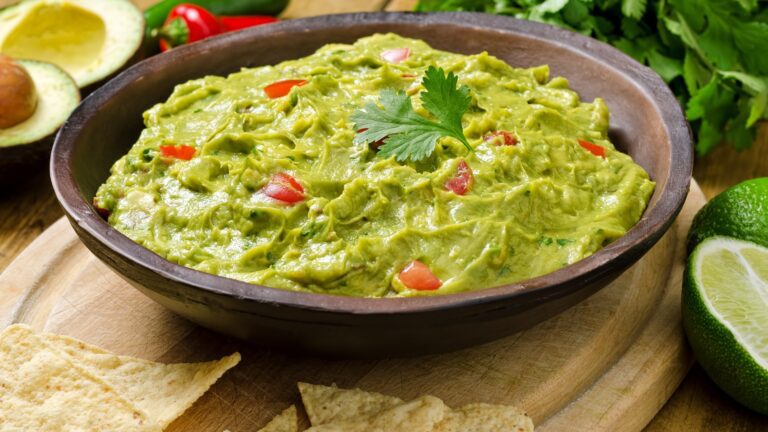The name derives from the Aztec word ahuacatl, transliterated as aguacate by the Spanish conquistadors, and the Mexican word mole, which means sauce. The dish’s origins can be traced back to Aztec ahuaca-hulli or avocado sauce. While numerous Central American cultures used the avocado for culinary purposes before its widespread cultivation, only the Aztecs have a specific recipe for something resembling guacamole.
“It’s simple to add jalapenos, chilli peppers, and hot sauce to your guacamole,” says Jordan Badger, a registered dietitian at Boston University’s Sargent Choice Nutrition Center. “For a sweeter flavour profile, add fruits like diced pineapples, dates, and grilled figs.”
Nutritional Values
Carbohydrate and Dietary fiber content
Guacamole nutrition contains a lot of good carbohydrates. A single 12-cup serving of this sauce contains about 12 grams of carbohydrates in the form of guacamole.
A 12-cup serving of guacamole contains about 8 grams of fiber. This cup has 8 grams of carbohydrates out of 12 grams, which means you only get about 4 grams of net carbs per serving.
Guacamole nutrition is a high source of fats, and as a result, it contains many calories. According to USDA, a 1-cup serving of guacamole contains 366 calories, with the fat content of the sauce accounting for more than half of those calories.
Minerals and Vitamins
Apart from fiber, carbs, and protein, plenty of healthy minerals and vitamins are contained in guacamole. The most notable mineral in guacamole is potassium, which is crucial for the circulatory and muscular systems of the body. Many people recognize bananas as the gold standard for potassium content. However, you will get 575 milligrams from a serving of guacamole, over 100 milligrams more than you would get from a medium-sized banana.
You will also get plenty of vitamin C and vitamin A from guacamole. Vitamin C is necessary for the healthy functioning of your immune system, while vitamin A aids your eyesight, notes the National Institute of health. According to USDA, a 1-cup serving of guacamole provides you with 16.3 micrograms of vitamin A and 24 milligrams of vitamin C.
Recipe | guacamole
PREP TIME: 10 mins
TOTAL TIME: 10 mins
SERVINGS: 2 to 4 servings
NOTE: Handle chilis with caution! It is best to use food-safe gloves. If gloves are not available, thoroughly wash your hands after handling them and avoid touching your eyes or the area around them for several hours.
Ingredients
- Two avocados, ripe
- 1/4 teaspoon kosher salt, plus additional salt to taste
- One tablespoon freshly squeezed lime or lemon juice
- 2 to 4 tbsp red onion minced or thinly sliced green onion
- 1 to 2 serrano (or jalapeno) chilis, minced, stems, and seeds removed
- Two tablespoons finely chopped cilantro (leaves and tender stems)
- One teaspoon freshly ground black pepper
- 1/2 ripe tomato, diced (optional)
- Slices of red radish or jicama for garnish (optional)
- To serve tortilla chips
Method
Cut the Avocado
Divide the avocados in half. Take out the pit. With a blunt knife, score the inside of the avocado and scoop out the flesh with a spoon. (For more information, see How to Cut and Peel an Avocado.) Place in a mixing bowl.
Mash Avocado
Mash the avocado roughly with a fork. (Don’t go overboard! (The guacamole should be chunky.)
To taste, add the remaining ingredients:
Season with salt and lime (or lemon) juice to taste. The acid in the lime juice will help balance the avocado’s richness and keep it from turning brown
Combine the chopped onion, cilantro, black pepper, and chilis in a mixing bowl. The spiciness of chili peppers varies by variety. So, start with half a chilli pepper and gradually add more to the guacamole to taste to the desired degree of heat.
Because of the variability of fresh ingredients, much of this is done to taste. Begin with this recipe and adjust it to your liking.
Serve right away:
If making ahead of time, place plastic wrap on the guacamole’s surface and press it to cover it to keep air out. (The oxygen in the air causes oxidation, which browns the guacamole.)
Garnish with red radish slices or jicama strips. Serve with your favourite store-bought tortilla chips or homemade tortilla chips.
Keep leftover guacamole in the refrigerator for up to 3 days.
Note chilling tomatoes reduces their flavor. If you want to include chopped tomato in your guacamole, do so right before serving.
Conclusion
Guacamole has several nutritional benefits in addition to being a possible aphrodisiac — and scientists have neither denied nor confirmed the validity of this claim. Avocados have more potassium than bananas, are high in vitamin A, and are the richest fruit source of beta-sitosterol, a compound that inhibits cholesterol absorption, and glutathione, an antioxidant. It contains additional antioxidants and vitamin C from tomatoes when cooked.
Avocados are well-known for their high-fat content. According to the Academy of Nutrition and Dietetics, they’re high in monounsaturated fats, which may help lower your risk of heart disease. Vitamins E and C, known for boosting the immune system, are essential for your body’s ability to metabolize and process protein.
And the advantages don’t stop there! Due to their high fiber content, avocados are commonly considered a weight-loss-friendly food. According to the Academy of Nutrition and Dietetics, fiber slows the rate at which your body breaks down food, allowing you to feel fuller for longer. In other words, eating avocado can help keep the munchies at bay.
We, at Crypto Food, offer several tips about the important aspects of food and a healthy lifestyle. We tend to assist you to arrange specifically for varied food varieties and supply you with complete help to browse our weblog to grasp additional tips.

